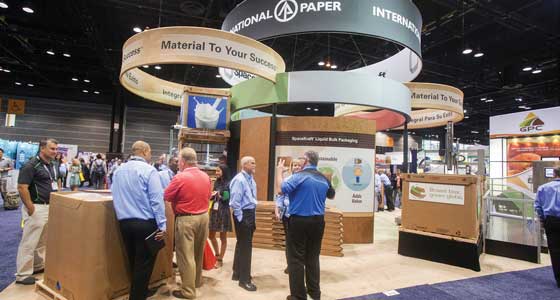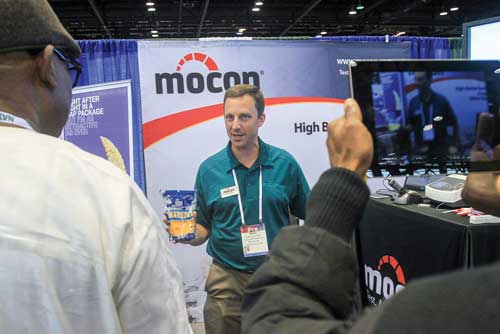The Packaging Scene at IFT16
How food packaging can enable clean label foods, reduce food waste, and incorporate emerging food processing techniques was showcased at IFT16 in symposia, short courses, poster sessions, and exhibits.

Packaging-related symposia and short courses allowed for a healthy exchange of ideas between industry and academia that moved the packaging field forward. The challenges of using high-pressure processing (HPP) and microwave-assisted thermal sterilization (MATS) in packaging were explored in several symposia. The Food Packaging Division’s 2016 Distinguished Lecturer, Shyam Sablani, an associate professor at Washington State University, discussed the design and development of packaging that is compatible with HPP and MATS. Baris Ates, a post-doctoral researcher at Nofima, discussed the packaging innovations needed to reduce packaging stress during forced convection processes. Chair-elect of the Food Packaging Division, Christopher Doona, senior research chemist at U.S. Army Natick Soldier Research, Development, and Engineering Center, covered the complex role of packaging in the short course “Commercialization of Nonthermal Technologies: Challenges and Advances.” And Hossein Daryaei, research scientist at Institute of Food Safety and Health, Illinois Institute of Technology, summarized research on the effect of HPP on barrier materials. The prospect of designing packages that improve food processing is promising.
Eva Almenar, associate professor at Michigan State University, gave a presentation on shelf-life simulation of packaged food, including methodologies, equations, and the need for more accelerated testing and modeling. During the panel discussion, Almenar commented on errors, data analysis, and mass transfer parameters associated with the methodolo-gies and equations and specific failure modes. Tom Clark, senior associate principal engineer at Mondelez International, also discussed shelf-life simulation, revealing how business decisions are affected.
Intelligent packaging applications to reduce food waste and fraud and to enhance marketing were the focus of another presentation. Jim Sinisgalli, director of market development at Systech, explained the complex anti-fraud packaging requirements of brand owners: “Leverage the existing package without changing or altering production and graphics while offering immediate authentication,” he said. He discussed how random micro-variances in existing graphics can enable smartphone verification through the entire supply chain. “The variances can’t be reverse-engineered and they provide a unique fingerprint that can be tracked for early diversion alerts and forensics analysis,” he said. John Spink and Doug Moyer, both assistant professors at Michigan State University, discussed the need for vulnerability assessments to guide packaging decision making. And I identified research and technologies that allow intelligent packaging to further reduce consumer-derived food waste.
Poster Competition
In the Food Packaging Division’s poster competition, six competitors were narrowed to one winner: Xi Wu of Purdue University. Wu’s research focused on how to tether an antimicrobial peptide to increase the efficacy of reducing E.coli O157:H7. “Antimicrobial peptides are short and can penetrate cell membranes, form pores, and cause cell death. I was able to tether the peptides using Maleimide-(PEG)-NHS ester cross-linkers and determine that the optimum molecular weight was 1218.34 g/mol (n=20),” Wu explained. Molecular dynamics simulation helped to confirm the results. In addition, Purdue researchers from other departments contributed to Wu’s research.
 On the Exhibit Floor
On the Exhibit Floor
Traffic was steady at the booths for Multisorb, Buffalo, New York (multisorb.com), and Clariant, Muttenz, Switzerland, (clariant.com). Clean label trends and the need to extend shelf life to decrease food waste fueled their popularity with attendees. For example, the Multisorb FreshMarket system reduces the amount of visible defects in strawberries by 80% after eight days. There is also increased interest in oxygen absorbers for case-ready meat (beef, pork, lamb, veal, and value-added seasoned meats). Clariant’s Oxy-Guard oxygen scavenger can reduce the oxidation of color, fats, oils, and vitamins and improve flavor by slowing down the deteriorative mechanisms of oxidation during shipping and throughout distribution. John Solomon, business development manager of active food packaging at Clariant, said, “We are at the show because Clariant offers a farm-to-table big-picture perspective.”
Blackhawk Molding Co. Inc., Addison, Ill. (blackhawkmolding.com), showcased an amazingly light (two grams) high-density polyethylene 38-mm REVO-cap. Major markets for this item include bottled water and dairy-based products. Expansion into other categories is possible with the REVO-cap that removes foil inner seals and dual color flip-top versions in polypropylene and low- and high-density polyethylene. “Blackhawk is designed to respond rapidly to customer needs, and this agility enabled a solution for a disposable cap for carboys in Rwanda and Uganda, resulting in a unique closure that allowed the package to be cost effective in this very low-cost market,” said Jeff Davis, Blackhawk Molding’s director of operations.
PakSense, Boise, Idaho (paksense.com), digitally monitors the temperature of loads from farm to retailer for its large produce market. Rachel Beckler, the company’s marketing communications manager, said, “The AutoSense system is used by Albertsons Companies … to ensure produce and other perishable foods meet their maximum shelf life and also as a vital tool to help comply with FSMA rules that relate to temperature monitoring.” The silicon-based digital sensor includes an array of integrated technology, enabling rapid temperature reading, recording, and analysis.
Food Packaging Division
The Food Packaging Division’s 2016 co-chairs, Almenar and Daryaei, finished a fabulous year by each receiving the 2016 Outstanding Leader Award. Brian Wagner was the 2016 Riester-Davis-Brody Award recipient. Jamie Valenti-Jordan received the 2016 Service Award for his dedication to the division, tireless work on the newsletter, and mentorship. Ziynet Boz received the 2016 Outstanding Volunteer Award for her amazing energy with the newsletter, social media, IFT Connect, and the division executive committee. She also won the 2016 student #IFTConnect contest.
Claire Koelsch Sand, PhD, is contributing editor to Food Technology magazine ([email protected])
